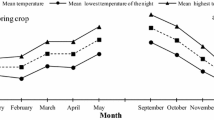Summary
After the induction of second growth, tubers may develop physiological rot following complete starch depletion. Tubers from two crops were graded into specific gravity classes after harvest and the development of decay was monitored during storage for 9 weeks. Most decay took place within the first 5 weeks. Tubers with a specific gravity<1.010 usually decayed completely. About 80% of tubers with a specific gravity>1.020 remained intact. In the specific gravity class 1.010–1.020 more than 50% of the tubers were affected, but they did not all decay completely.
Similar content being viewed by others
References
Bodlaender, K.B.A., C. Lugt & J. Marinus, 1964. The induction of second-growth in potato tubers.European Potato Journal 7: 57–71.
Chung, B., D. Armstrong & S. Grice, 1988. Effect of irrigation frequency on the incidence of second growth of Russet Burbank potatoes in north-west Tasmania.Journal of Agricultural Science 111: 399–402.
Hiller, L.K., D.C. Koller & R.E. Thornton, 1985. Physiological disorders of potato tubers. In: P.H. Li (ed.),Potato Physiology, Orlando, Academic Press, 586 pp.
Iritani, W.M., 1981. Growth and preharvest stress and processing quality of potatoes.American Potato Journal 58: 71–80.
Iritani, W.M. & L. Weller, 1973. The development of translucent end tubers.American Potato Journal 50: 223–233.
Ludwig, J.W., 1972.Bepaling van het droge-stofgehalte van aardappelen via onderwaterweging. Publikatie 247, IBVL, 12 pp.
Lugt, C., 1960. Second-growth phenomena.European Potato Journal 3: 307–324.
Lugt, C., K.B.A. Bodlaender & G. Goodijk, 1964. Observations on the induction of secondgrowth in potato tubers.European Potato Journal 7: 219–227.
Münster, J. & W. Reust, 1977. Sensibilié des variétés de pommes de terre de l'assortiment suisse à la vitrosité et détermination de ce phénomène par le poids spécifiques.Revue Suisse d'Agriculture 9: 53–58.
Verma, S.C., K.C. Joshi, T.R. Sharma & V.P. Malhotra, 1972. Relation between specific gravity and dry matter content of potato (Solanum tuberosum L.).Indian Journal of Agricultural Science 42: 709–712.
Verma, S.C. V.P. Malhotra, K.C. Joshi & T.R. Sharma, 1971. Specific gravity and dry matter content of potato.Potato Research 14: 94–95.
Author information
Authors and Affiliations
Rights and permissions
About this article
Cite this article
Veerman, A., Van Loon, C.D. Post-harvest decay of second growth-induced glassy tubers of potato (Solanum tuberosum L.) cv. Bintje in relation to their specific gravity. Potato Res 38, 391–397 (1995). https://doi.org/10.1007/BF02357744
Accepted:
Issue Date:
DOI: https://doi.org/10.1007/BF02357744




